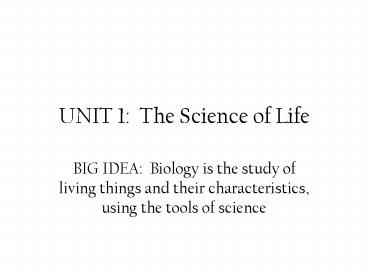UNIT 1: The Science of Life - PowerPoint PPT Presentation
1 / 42
Title:
UNIT 1: The Science of Life
Description:
UNIT 1: The Science of Life BIG IDEA: Biology is the study of living things and their characteristics, using the tools of science The independent variable is the ... – PowerPoint PPT presentation
Number of Views:137
Avg rating:3.0/5.0
Title: UNIT 1: The Science of Life
1
UNIT 1 The Science of Life
- BIG IDEA Biology is the study of living things
and their characteristics, using the tools of
science
2
Part1 How do we know if something is alive?
3
- Characteristics of Life
- Cellular Organization
- Use Energy for Metabolism
- Growth and Development
- Respond to Stimuli
- Homeostasis
- Reproduce
- Heredity
4
Cellular Organization
- A cell is the smallest unit capable of all life
functions - Levels of Organization
- Cells ? Tissues ? Organs ? Organ Systems ?Organism
5
A
C
B
6
Use Energy
- Energy is needed to run life sustaining chemical
reactions, like movement, growth, and repair. - Metabolism is the sum of all these reactions.
7
Metabolism
- Metabolism manages the energy and material
resources in a cell. - There are two basic types.
8
Catabolic
- Break down large molecules
- Releases/ Stores energy
- For example, cellular respiration is the process
that breaks down sugar molecules into small
energy storing molecules
9
Anabolic
- Build larger molecules
- Uses energy
- For example, protein synthesis is the building of
large proteins from smaller molecules called
amino acids.
10
Growth and Development
- Growth increase of living matter (making more
cells) - Development change into mature adult
11
Response to Stimuli
- Stimulus a change in the environment
- Organism respond and react to changes around them
- For example, animals run from predators.
- Think of stimuli you react to.
12
(No Transcript)
13
(No Transcript)
14
Homeostasis
- Homeostasis to maintain the same internal
environment in response to changes in the
external environment - What internal changes does your body regulate?
15
Homeostasis
- Some examples temperature, water and salt
levels, blood sugar levels
16
Reproduction
- Process by which organisms make more of their own
kind - Necessary for the survival of the species
- Asexual and sexual
17
Heredity
- Organisms pass hereditary information in genes to
their offspring. - Genes are encoded in the molecule called DNA
- Allows for adaptations and changes through time
18
Tell what characteristics of life each item has.
- Seed
- Volcano
- Chicken egg
- Bread dough
- Moldy bread
- A branch off a tree
19
DO NOW
- Think of a characteristic of life that a
nonliving object might display and explain what
it is.
20
Tools Used by Biologists Study Living Things
- Scientific Method
- Microscope
- Metric System
21
Scientific Method
22
Identify the Problem/Purpose
- Often developed from observations made of nature.
23
Hypothesis and Prediction
- A hypothesis is a proposed explanation for the
stated problem. - It must be testable!
- Then scientists can make a prediction for the
outcome of your experiment. - Predictions can be stated as If. Then
statement.
24
Design an Experiment
- Use a controlled experiment to test your
hypothesis. - Keep all the test conditions the same except for
the variable you are testing
25
Record Observations/Data/Results
- Collect data in the form of measurements and
observations about experiment. - Reported in metric/SI units
26
Two types of Data
- Quantitative
- Data that uses numerical values, measurements
- E.g. mass, temperature
- Qualitative
- Data that uses descriptions.
- E.g. color, odor, texture
27
Analysis
- Explain your observations, data, and results.
- List the main points that you have learned.
- Was your hypothesis correct?
28
Conclusion
- Answer your problem/purpose statement.
- What would be the next question to ask?
- Remember! Your hypothesis is never PROVEN
true. It is either rejected or not rejected.
29
Share the Information
- Publish your findings in journals.
30
Theory
- Many accepted hypotheses that explain a similar
topic form a theory. - May be revised or replaced!
31
Designing a Controlled Experiment
- A controlled experiment compares a control group
against an experimental group.
32
- A control group provides a normal standard that
is used to compare with the experiment group.
33
- The experimental group is the same as the control
group, except for the one variable that is being
tested.
34
- The independent variable is the factor that is
being tested, which changes from the control
group to the experiment group. It is chosen by
the scientist.
35
- The dependent variable is the result of the
experiment and is the factor that is observed and
measured. It depends on what is tested.
36
- Why does a good experiment control for variables?
37
Metric System
- SI units
38
Scientists Report Measurements as
- Mass
- Volume
- Length
gram
liter
meter
39
Prefix Abbreviation Factor of Base Unit
giga G 1,000,000,000
mega M 1,000,000
kilo k 1,000
hecto h 100
deka da 10
--- --- 1
deci d 0.1
centi c 0.01
mili m 0.001
micro µ 0.000001
nano n 0.000000001
Angstrom Å 0.0000000001
pico p 0.000000000001
40
Converting SI units
- To move from a LARGER unit ? SMALLER unit gt
MULTIPLY - To move from a SMALLER unit ? LARGER unit gt
DIVIDE - Multiply/Divide by POWERS OF 10
41
SI units are in POWERS OF 10,
- to multiply move the decimal to the right.
- to divide, move the decimal to the left.
42
Move the Decimal
- 1.0 kg 1000.0 g 1,000,000.0 mg
- 1 mm 0.1 cm 0.001 m 0.000001 km
- 4.5678 kg 4567.8 g 4567800 mg































